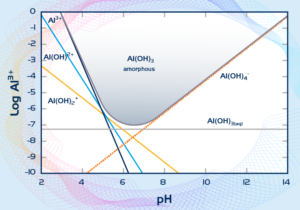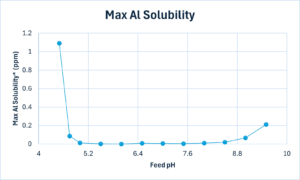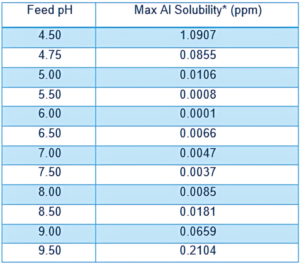Aluminum is extremely insoluble in water in the neutral pH range (6-8 pH), especially in natural water sources. A concentration of 0.5 ppm Al at pH 8 is very unlikely. Below is aluminum pH vs. speciation diagram.

Even though Al is about 85X more soluble at pH 8 compared to pH 6, the solubility is still less than 0.01 ppm at pH 8 (see below table for the maximum concentrations of dissolved aluminium) It is therefore essential to determine how the measurement of 0.5 ppm was obtained to determine aluminum scaling/fouling.


*Values calculated using AWC Proton® projection software
Erroneous aluminum values are often a result of the water collection and analysis procedures. The most common method for analysis of aluminium is total metals by ICP (EPA Method 200.7) Total metals require preservation of the sample and/or digestion by acid to ensure that all metals are dissolved prior to being analyzed. As many silts and clays are aluminum silicates, the acid preservation/digestion can leach aluminum from these silicates into the solution, resulting in a misleading value in the water analysis. Silts and clays will likely be contaminants within the water, regardless of whether the source is a groundwater or surface water. Filtration during sample collection would eliminate this problem.
Another source of aluminum may be due to the addition of an aluminum-based coagulant, typically aluminum sulfate (alum) and Poly aluminum chloride (PACl). Once the coagulant reacts with water, colloidal Al(OH)3 particles are formed, and if not fully removed, can foul the RO membranes. Antiscalants can be used to control colloidal aluminum but only within reason. It is unrealistic to expect control beyond 1 – 1.5 ppm Al in the RO concentrate in the neutral pH range. For a system operating at 90% recovery, 0.1 – 0.15 ppm Al in the feed water would be a realistic limit.
This colloidal aluminum can be filtered by MF or UF but would pass through media filtration.
The analysis of filtered water samples, as mentioned above, cannot distinguish between colloidal aluminum from excess coagulant or aluminium silicates. If coagulation is a potential source of high aluminum in the feed water, it’s important to identify it so that the coagulation process can better be optimized. In such a situation, the analysis of filtered samples may be misleading, so it’s always important to compare the analysis of a filtered sample vs. an unfiltered one. The concentration of aluminum in the water analysis would often provide sufficient context, however, when in doubt, the filter can be analyzed by SEM/EDS to determine whether the aluminum was leached from silts/clays or if it was actually in the form of colloidal aluminum hydroxide.
However, there is an exception to this extremely low aluminum solubility. In industrial or municipal wastewater high in organics, the organic acids can form soluble complexes with aluminum. This would be somewhat similar to Al being chelated by EDTA. In such cases, extremely high aluminum values can be measured, and would not be filterable. Therefore, the filtered sample would have a similar or identical value to that of the unfiltered sample. The aluminum can be presumed to be soluble in those situations, and a 0.1 ppm safety value should be entered into the antiscalant projection.
At pH < 5 and pH > 9, aluminum solubility increases dramatically. One useful approach is to enter the water analysis into Proton and check the Scaling Potentials calculations at 0% recovery. If there are no warnings about Al(OH)3 or AlPO4 scale formation, then the aluminum value can be considered realistic. But if Proton gives a warning about the values being above saturation, then the values should be reassessed with the same logic outlined above.
Antiscalants are sensitive to the presence of metals like iron and aluminum, which can either deactivate or taint the antiscalant. It’s important to select the right antiscalant so no aluminum scale or antiscalant fouling occurs.
AWC A-119 is an aluminum tolerant antiscalant that is excellent for use with aluminum-containing feedwaters, however, its efficacy will be limited to aluminum concentrations that can be realistically controlled in the concentrate. This is, as discussed above, dependant on the specifics of the water.

